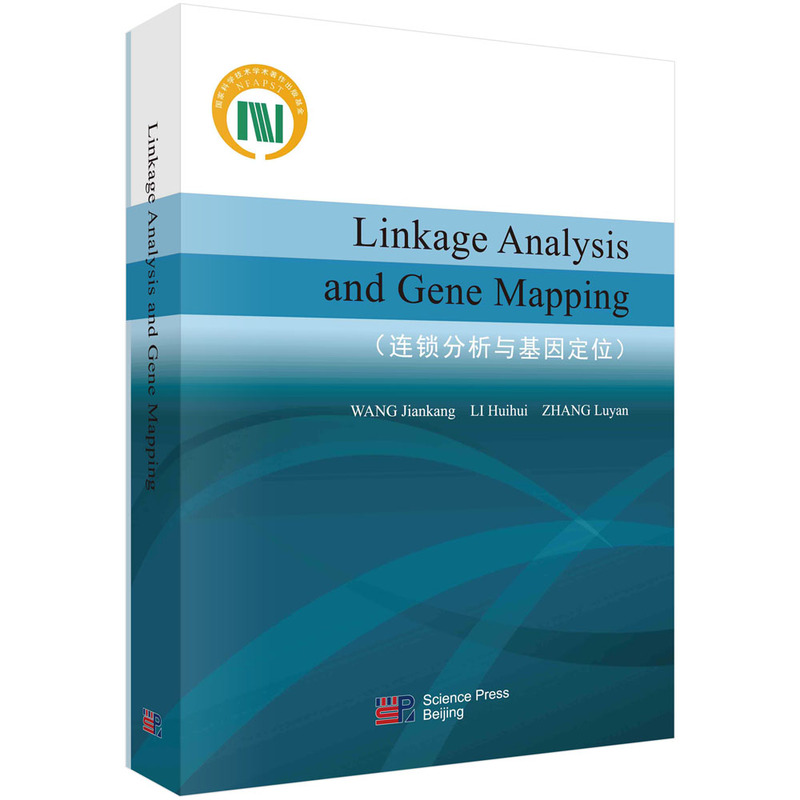暂无评论
图文详情
- ISBN:9787030757616
- 装帧:平装胶订
- 册数:暂无
- 重量:暂无
- 开本:其他
- 页数:532
- 出版时间:2023-06-01
- 条形码:9787030757616 ; 978-7-03-075761-6
内容简介
本书建立在作者十多年科研和教学的基础之上,全书可分为三部分。第1章为**部分,介绍遗传研究群体,主要内容包括常见群体类型、基因型数据的初步整理和分析、基因效应和遗传方差的定义和计算、单环境和多环境表型观测值的方差分析、以及基因型值和遗传力的估计等内容。第2~3章为第二部分,介绍双亲群体连锁分析和遗传图谱构建,主要内容包括世代转移矩阵、两个座位上基因型的理论频率、两个基因座位间重组率的估算、作图函数和遗传图谱构建算法等内容。第4~10章为第三部分,介绍数量性状基因的作图原理和方法,主要内容包括单标记分析、简单区间作图、完备区间作图方法、上位型互作、与环境互作的QTL作图,以及有选择群体、自然群体、无性系杂交群体和多亲本群体的基因定位等内容。
目录
Preface
CHAPTER 1 PopulationsinGeneticStudies
1.1 CommonlyUsedPopulationsinGeneticStudies
1.1.1 Bi-ParentalPopulations
1.1.2 Multi-ParentalPopulations
1.1.3 Considerations in Developing Genetic Populations
1.2 PreliminaryAnalysisofGenotypicData
1.2.1 CollectionandCodingofGenotypicData
1.2.2 Gene Frequency and Genotypic Frequency
1.2.3 FitnessTestonGenotypicFrequencies
1.3 GeneticEffectandGeneticVariance
1.3.1 Calculation of Population Mean and Phenotypic Variance
1.3.2 One-Locus Additive and Dominance Model
1.3.3 Population Mean and Genetic Variance at One Locus
1.4 ANOVAonSingleEnvironmentTrials
1.4.1 Linear Decomposition on Phenotypic Observation
1.4.2 Decomposition of Sum of Squares of Phenotypic Deviations
1.4.3 Single Environmental ANOVA on Rice Grain Length
1.5 ANOVAonMulti-EnvironmentTrials
1.5.1 Linear Decomposition on Phenotypic Observation
1.5.2 Decomposition of Sum of Squares of Phenotypic Deviations
1.5.3 Multi-Environmental ANOVA on Rice Grain Length
1.6 Estimation of Genotypic Values and the Broad-Sense Heritability
1.6.1 Genotypic Values and Broad-Sense Heritability fromSingleEnvironmentalTrials
1.6.2 Genotypic Values and Broad-Sense Heritability fromMulti-EnvironmentalTrials
1.6.3 Estimation of Genotypic Values Under Heterogeneous Error Variances 42 Exercises
CHAPTER 2 Estimation of the Two-Point Recombination Frequencies
2.1 GenerationTransitionMatrix
2.1.1 Usefulness of the Transition Matrix in Linkage Analysis
2.1.2 Transition Matrix of One Generation of Backcrossing
2.1.3 Transition Matrix of One Generation of Selfing
2.1.4 TransitionMatrixofDoubledHaploid
2.1.5 TransitionMatrixofRepeatedSelfing
2.1.6 Expression of the Two-Locus Genotypic Frequencies inMatrixFormat
2.2 Theoretical Genotypic Frequencies at Two Loci
2.2.1 Theoretical Frequencies of 10 Genotypes at Two Loci
2.2.2 Theoretical Frequencies of 4 Homozygotes in Permanent Populations
2.2.3 Genotypic Frequencies of Two Co-Dominant Loci inTemporaryPopulations
2.2.4 Genotypic Frequencies of One Co-Dominant Locus and One Dominant Locus in Temporary Populations
2.2.5 Genotypic Frequencies of One Co-Dominant Locus and One Recessive Locus in Temporary Populations
2.2.6 Genotypic Frequencies of Two Dominant Loci in Temporary Populations
2.2.7 Genotypic Frequencies of One Dominant Locus and One Recessive Locus in Temporary Populations
2.2.8 Genotypic Frequencies of Two Recessive Loci in Temporary Populations
2.3 Estimation of Two-Point Recombination Frequency
2.3.1 Maximum Likelihood Estimation of Recombination FrequencyinDHPopulations
2.3.2 General Procedure on the Maximum Likelihood Estimation ofRecombinationFrequency
2.3.3 Estimation of Recombination Frequency Between One Co-Dominant and One Dominant Marker in F2 population
2.3.4 InitialValuesinNewtonAlgorithm
2.3.5 EM Algorithm in Estimating Recombination Frequency in F2 Populations
2.3.6 Effects on the Estimation of Recombination Frequency from SegregationDistortion
Exercises
CHAPTER 3 Three-Point Analysis and Linkage Map Construction
3.1 Three-Point Analysis and Mapping Function
3.1.1 Genetic Interference and Coefficient of Interference
3.1.2 Mapping Function
3.2 ConstructionofGeneticLinkageMaps
3.2.1 MarkerGroupingAlgorithm
3.2.2 MarkerOrderingAlgorithm
3.2.3 Use of the k-Optimal Algorithm in Linkage Map Construction
3.2.4 RipplingoftheOrderedMarkers
3.2.5 IntegrationofMultipleMaps
3.3 Comparison of the Recombination Frequency Estimation in Different Populations
3.3.1 LOD Score in Testing the Linkage Relationship in Different Populations
3.3.2 Accuracy of the Estimated Recombination Frequency
3.3.3 Least Population Size to Declare the Significant Linkage RelationshipandCloseLinkage
3.4 Linkage Analysis in Random Mating Populations
3.4.1 Linkage Dis-Equilibrium in Random Mating Populations
3.4.2 Generation Transition Matrix from Diploid Genotypes toHaploidGametes
3.4.3 Gametic and Genotypic Frequencies in Populations After SeveralGenerationsofRandomMating 132 Exercises
CHAPTER 4 Single Marker Analysis and Simple Interval Mapping
4.1 SingleMarkerAnalysis
4.1.1 Phenotypic Means of Different Genotypes at One Marker Locus
4.1.2 Single Marker Analysis by t-Test in Populations with Two Genotypes
4.1.3 Single Marker Analysis by t-Test in Populations with Three Genotypes
4.1.4 ANOVA in Single Marker Analysis in Populations with Three Genotypes
4.1.5 Likelihood Ratio Test in Single Marker Analysis
4.1.6 ProblemswithSingleMarkerAnalysis
4.2 SimpleIntervalMapping
4.2.1 Frequencies of the QTL Genotypes in a Marker Interval
4.2.2 Maximum Likelihood Estimation of Phenotypic Means ofQTLGenotypes
4.2.3 TestingfortheExistenceofQTL
4.2.4 Estimation
……
CHAPTER 5 Inclusive Composite Interval Mapping
CHAPTER 6 QTL Mapping for Epistasis and Genotype-by-Environment Interaction
CHAPTER 7 Genetic Analysis in Hybrid F1 of Two Heterozygous Parentsana Domble-Cross F1 of Four Homozygous Parents
CHAPTER 8 Genetic Analysis in Multi-Parental Pure-Line Progeny Populations.
CHAPTER 9 QTL Mapping in Other Genetic Populations
CHAPTER 10 More on the Frequently Asked Questions in QTL Mapping
References
Index
Appendix A:Journal Articles Making Up This Book
Appendix B:Dissertations of Post-Graduates Making Up This Book
Appendix C:Integrated Software Packages Making Up This Book
展开全部
本类五星书
浏览历史
本类畅销
-

流行草花图鉴
¥4.8¥13.0 -

马蹄实用栽培和加工技术
¥12.8¥32.8 -

药用植物图鉴
¥29.3¥45.0 -

南瓜栽培新技术
¥3.2¥7.5 -

禽病鉴别诊断与防治-(第2版 )
¥4.5¥11.0 -

小浆果栽培技术
¥6.1¥19.0 -

现代花卉园艺学原理与切花百合生产技术
¥11.0¥37.0 -

玉米生产技术大全(第二版)
¥50.6¥80.0 -

中国畜禽种业发展报告2024
¥75.6¥120.0 -

农业推广
¥41.1¥68.0 -

高标准农田建设标准体系构建及投入机制研究——以典型稻麦区为例
¥66.0¥100.0 -

药食同源中药材实用栽培技术
¥31.8¥54.0 -

现代糯高粱绿色生产技术
¥34.6¥60.0 -

土壤农化分析 第三版
¥37.3¥55.0 -

高粱绿色高效生产技术
¥34.7¥45.0 -

大豆绿色高质高效生产技术
¥22.0¥35.0 -

玉米绿色生产技术
¥22.0¥35.0 -

现代农业种植技术
¥49.4¥88.0 -

常见树木图鉴
¥14.0¥48.0 -

游动的宝石——锦鲤
¥67.0¥88.0













